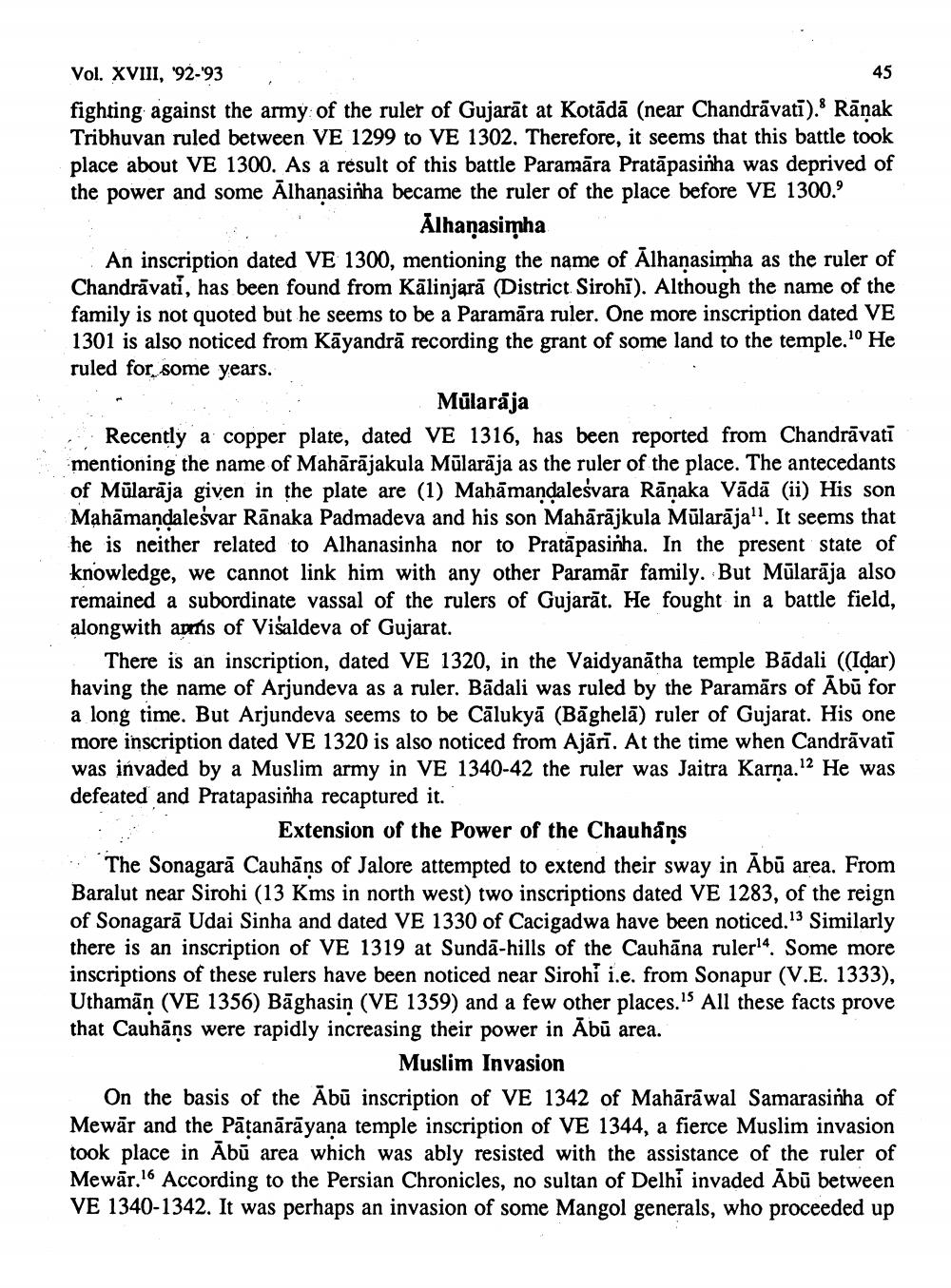________________
Vol. XVIII, 92-'93
45 fighting against the army of the ruler of Gujarat at Kotādā (near Chandrāvati). Rānak Tribhuvan ruled between VE 1299 to VE 1302. Therefore, it seems that this battle took place about VE 1300. As a result of this battle Paramāra Pratāpasiñha was deprived of the power and some Ālhanasinha became the ruler of the place before VE 1300.
Alhaņasimha An inscription dated VE 1300, mentioning the name of Alhanasimha as the ruler of Chandrāvati, has been found from Kālinjarā (District Sirohi). Although the name of the family is not quoted but he seems to be a Paramāra ruler. One more inscription dated VE 1301 is also noticed from Kāyandrā recording the grant of some land to the temple. He ruled for some years.
Mülaraja Recently a copper plate, dated VE 1316, has been reported from Chandrāvati mentioning the name of Mahārājakula Mūlarāja as the ruler of the place. The antecedants of Mūlarāja given in the plate are (1) Mahāmandalesvara Rānaka Vādā (ii) His son Mahāmandalesvar Ranaka Padmadeva and his son Mahārājkula Mūlarāja". It seems that he is neither related to Alhanasinha nor to Pratāpasinha. In the present state of knowledge, we cannot link him with any other Paramār family. But Mūlarāja also remained a subordinate vassal of the rulers of Gujarāt. He fought in a battle field, alongwith arms of Visaldeva of Gujarat.
There is an inscription, dated VE 1320, in the Vaidyanātha temple Bādali ((Idar) having the name of Arjundeva as a ruler. Badali was ruled by the Paramārs of Ābū for a long time. But Arjundeva seems to be Cālukyā (Bāghelā) ruler of Gujarat. His one more inscription dated VE 1320 is also noticed from Ajāri. At the time when Candrāvati
invaded by a Muslim army in VE 1340-42 the ruler was Jaitra Karna.12 He was defeated and Pratapasinha recaptured it.
Extension of the Power of the Chauhans * The Sonagarā Cauhāns of Jalore attempted to extend their sway in Abū area. From Baralut near Sirohi (13 Kms in north west) two inscriptions dated VE 1283, of the reign of Sonagarā Udai Sinha and dated VE 1330 of Cacigadwa have been noticed.13 Similarly there is an inscription of VE 1319 at Sundā-hills of the Cauhāna ruler14. Some more inscriptions of these rulers have been noticed near Sirohi i.e. from Sonapur (V.E. 1333), Uthamān (VE 1356) Bāghasin (VE 1359) and a few other places. All these facts prove that Cauhāns were rapidly increasing their power in Abū area.
Muslim Invasion On the basis of the Ābū inscription of VE 1342 of Mahārāwal Samarasinha of Mewar and the Pātanārāyana temple inscription of VE 1344, a fierce Muslim invasion took place in Abū area which was ably resisted with the assistance of the ruler of Mewar.16 According to the Persian Chronicles, no sultan of Delhi invaded Abū between VE 1340-1342. It was perhaps an invasion of some Mangol generals, who proceeded up




